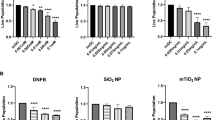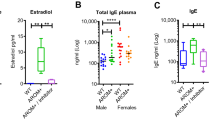Abstract
Bisphenol A (BPA) is a monomer used in manufacturing a wide range of chemical products, including epoxy resins and polycarbonate. BPA, an important endocrine disrupting chemical that exerts estrogen-like activities, is detectable at nanomolar levels in human serum worldwide. The pregnancy associated doses of 17β-estradiol (E2) plus tumor-necrosis factor-α (TNF-α) induce distorted maturation of human dendritic cells (DCs) that result in an increased capacity to induce T helper (Th) 2 responses. The current study demonstrated that the presence of BPA during DC maturation influences the function of human DCs, thereby polarizing the subsequent Th response. In the presence of TNF-α, BPA treatment enhanced the expression of CC chemokine ligand 1 (CCL1) in DCs. In addition, DCs exposed to BPA/TNF-α produced higher levels of IL-10 relative to those of IL-12p70 on CD40 ligation, and preferentially induced Th2 deviation. BPA exerts the same effect with E2 at the same dose (0.01–0.1 µΜ) with regard to DC-mediated Th2 polarization. These findings imply that DCs exposed to BPA will provide one of the initial signals driving the development and perpetuation of Th2-dominated immune response in allergic reactions.
This is a preview of subscription content, access via your institution
Access options
Subscribe to this journal
Receive 12 digital issues and online access to articles
$119.00 per year
only $9.92 per issue
Buy this article
- Purchase on Springer Link
- Instant access to full article PDF
Prices may be subject to local taxes which are calculated during checkout






Similar content being viewed by others
References
Ring J, Kramer U, Schafer T, Behrendt H . Why are allergies increasing? Curr Opin Immunol 2001; 13: 701–708.
McGeady SJ . Immunocompetence and allergy. Pediatrics 2004; 113: 1107–1113.
Safe SH . Environmental and dietary estrogens and human health: is there a problem? Environ Health Perspect 1995; 103: 346–351.
Kelce WR, Wilson EM . Environmental antiandrogens: developmental effects, molecular mechanisms, and clinical implications. J Mol Med 1997; 75: 198–207.
Ohshima Y, Yamada A, Tokuriki S, Yasutomi M, Omata N, Mayumi M . Transmaternal exposure to bisphenol A modulates the development of oral tolerance. Pediatr Res 2007; 62: 60–64.
vom Saal FS, Hughes C . An extensive new literature concerning low-dose effects of bisphenol A shows the need for a new risk assessment. Environ Health Perspect 2005; 113: 926–933.
Le HH, Carlson EM, Chua JP, Belcher SM . Bisphenol A is released from polycarbonate drinking bottles and mimics the neurotoxic actions of estrogen in developing cerebellar neurons. Toxicol Lett 2008; 176: 149–156.
Welshons WV, Nagel SC, vom Saal FS . Large effects from small exposures. III. Endocrine mechanisms mediating effects of bisphenol A at levels of human exposure. Endocrinology 2006; 147: S56–S69.
Witorsch RJ . Low-dose in utero effects of xenoestrogens in mice and their relevance to humans: an analytical review of the literature. Food Chem Toxicol 2002; 40: 905–912.
Kurosawa T, Hiroi H, Tsutsumi O, Ishikawa T, Osuga Y, Fujiwara T et al. The activity of bisphenol A depends on both the estrogen receptor subtype and the cell type. Endocr J 2002; 49: 465–471.
Prossnitz ER, Arterburn JB, Smith HO, Oprea TI, Sklar LA, Hathaway HJ . Estrogen signaling through the transmembrane G protein-coupled receptor GPR30. Annu Rev Physiol 2008; 70: 165–190.
Singleton DW, Feng Y, Chen Y, Busch SJ, Lee AV, Puga A et al. Bisphenol-A and estradiol exert novel gene regulation in human MCF-7 derived breast cancer cells. Mol Cell Endocrinol 2004; 221: 47–55.
Singleton DW, Feng Y, Yang J, Puga A, Lee AV, Khan SA . Gene expression profiling reveals novel regulation by bisphenol-A in estrogen receptor-alpha-positive human cells. Environ Res 2006; 100: 86–92.
Goto M, Takano-Ishikawa Y, Ono H, Yoshida M, Yamaki K, Shinmoto H . Orally administered bisphenol A disturbed antigen specific immunoresponses in the naive condition. Biosci Biotechnol Biochem 2007; 71: 2136–2143.
Ohshima Y, Yamada A, Tokuriki S, Yasutomi M, Omata N, Mayumi M . Transmaternal exposure to bisphenol A modulates the development of oral tolerance. Pediatr Res 2007; 62: 60–64.
Yan H, Takamoto M, Sugane K . Exposure to Bisphenol A prenatally or in adulthood promotes TH2 cytokine production associated with reduction of CD4+CD25+ regulatory T cells. Environ Health Perspect 2008; 116: 514–519.
Tian X, Takamoto M, Sugane K . Bisphenol A promotes IL-4 production by Th2 cells. Int Arch Allergy Immunol 2003; 132: 240–247.
Yoshino S, Yamaki K, Yanagisawa R, Takano H, Hayashi H, Mori Y . Effects of bisphenol A on antigen-specific antibody production, proliferative responses of lymphoid cells, and TH1 and TH2 immune responses in mice. Br J Pharmacol 2003; 138: 1271–1276.
Banchereau J, Steinman RM . Dendritic cells and the control of immunity. Nature 1998; 392: 245–252.
Kalinski P, Hilkens CM, Wierenga EA, Kapsenberg ML . T-cell priming by type-1and type-2 polarized dendritic cells: the concept of a third signal. Immunol Today 1999; 20: 561–567.
Wilson NJ, Boniface K, Chan JR, McKenzie BS, Blumenschein WM, Mattson JD et al. Development, cytokine profile and function of human interleukin 17-producing helper T cells. Nat Immunol 2007; 8: 950–957.
van Beelen AJ, Zelinkova Z, Taanman-Kueter EW, Muller FJ, Hommes DW, Zaat SA et al. Stimulation of the intracellular bacterial sensor NOD2 programs dendritic cells to promote interleukin-17 production in human memory T cells. Immunity 2007; 27: 660–669.
Korn T, Bettelli E, Oukka M, Kuchroo VK . IL-17 and Th17 cells. Annu Rev Immunol 2009; 27: 485–517.
Kapsenberg ML . Dendritic-cell control of pathogen-driven T-cell polarization. Nat Rev Immunol 2003; 3: 984–993.
Liu TY, Uemura Y, Suzuki M, Narita Y, Hirata S, Ohyama H et al. Distinct subsets of human invariant NKT cells differentially regulate T helper responses via dendritic cells. Eur J Immunol 2008; 38: 1012–1023.
Aste-Amezaga M, Ma X, Sartori A, Trinchieri G . Molecular mechanisms of the induction of IL-12 and its inhibition by IL-10. J Immunol 1998; 160: 5936–5944.
Yang L, Anderson DE, Baecher-Allan C, Hastings WD, Bettelli E, Oukka M et al. IL-21 and TGF-β are required for differentiation of human TH17 cells. Nature 2008; 454: 350–352.
Traidl-Hoffmann C, Mariani V, Hochrein H, Karg K, Wagner H, Ring J et al. Pollen-associated phytoprostanes inhibit dendritic cell interleukin-12 production and augment T helper type 2 cell polarization. J Exp Med 2005; 201: 627–636.
Ohtani T, Nakagawa S, Kurosawa M, Mizuashi M, Ozawa M, Aiba S . Cellular basis of the role of diesel exhaust particles in inducing Th2-dominant response. J Immunol 2005; 174: 2412–2419.
Sasaki Y, Ohtani T, Ito Y, Mizuashi M, Nakagawa S, Furukawa T et al. Molecular events in human T cells treated with diesel exhaust particles or formaldehyde that underlie their diminished interferon-gamma and interleukin-10 production. Int Arch Allergy Immunol 2009; 148: 239–250.
Uemura Y, Liu TY, Narita Y, Suzuki M, Matsushita S . 17 beta-estradiol (E2) plus tumor necrosis factor-alpha induces a distorted maturation of human monocytes-derived dendritic cells and promotes their capacity to initiate T-helper 2 responses. Hum Immunol 2008; 69: 149–157.
Uemura Y, Liu TY, Narita Y, Suzuki M, Ohshima S, Muzukami S et al. Identification of functional type 1 ryanodine receptors in human dendritic cells. Biochem Biophys Res Commun 2007; 362: 510–515.
Uemura Y, Suzuki M, Liu TY, Narita Y, Hirata S, Ohyama H et al. Role of human non-invariant NKT lymphocytes in the maintenance of type 2 T helper environment during pregnancy. Int Immunol 2008; 20: 405–412.
Langenkamp A, Messi M, Lanzavecchia A, Sallusto F . Kinetics of dendritic cell activation: impact on priming of TH1, TH2 and nonpolarized T cells. Nat Immunol 2000; 1: 311–316.
de Jong EC, Vieira PL, Kalinski P, Schuitemaker JH, Tanaka Y, Wierenga EA et al. Microbial compounds selectively induce Th1 cell-promoting or Th2 cell-promoting dendritic cells in vitro with diverse Th cell-polarizing signals. J Immunol 2002; 168: 1704–1709.
Kuiper GG, Lemmen JG, Carlsson B, Corton JC, Safe SH, van der Saag PT et al. Interaction of estrogenic chemicals and phytoestrogens with estrogen receptor beta. Endocrinology 1998; 139: 4252–4263.
Safe SH, Pallaroni L, Yoon K, Gaido K, Ross S, McDonnell D . Problems for risk assessment of endocrine-active estrogenic compounds. Environ Health Perspect 2002; 110: 925–929.
Watson CS, Bulayeva NN, Wozniak AL, Finnerty CC . Signaling from the membrane via membrane estrogen receptor-alpha: estrogens, xenoestrogens, and phytoestrogens. Steroids 2005; 70: 364–371.
Alonso-Magdalena P, Laribi O, Ropero AB, Fuentes E, Ripoll C, Soria B et al. Low doses of bisphenol A and diethylstilbestrol impair Ca2+ signals in pancreatic alpha-cells through a nonclassical membrane estrogen receptor within intact islets of Langerhans. Environ Health Perspect 2005; 113: 969–977.
Thomas P, Dong J . Binding and activation of the seven-transmembrane estrogen receptor GPR30 by environmental estrogens: a potential novel mechanism of endocrine disruption. J Steroid Biochem Mol Biol 2006; 102: 175–179.
Compbell RA, Bhat-Nakshatri P, Patel NM, Constantinidou D, Ali S, Nakshatri H . Phosphatidylinositol 3-kinase/AKT-mediated activation of estrogen receptoralpha: a new model for anti-estrogen resistance. J Biol Chem 2001; 276: 9817–9824.
McDonnell DP, Norris JD . Connections and regulation of the human estrogen receptor. Science 2002; 296: 1642–1644.
Gombert M, Dieu-Nosjean MC, Winterberg F, Bunemann E, Kubitza RC, Da Cunha L et al. CCL1-CCR8 interactions: an axis mediating the recruitment of T cells and Langerhans-type dendritic cells to sites of atopic skin inflammation. J Immunol 2005; 174: 5082–5091.
Ruckes T, Saul D, van Snick J, Hermine O, Grassmann R . Autocrine antiapoptotic stimulation of cultured adult T-cell leukemia cells by overexpression of the chemokine I-309. Blood 2001; 98: 1150–1159.
Moser M, Murphy KM . Dendritic cell regulation of TH1-TH2 development. Nat Immunol 2000; 1: 199–205.
Roses RE, Xu S, Xu M, Koldovsky U, Koski G, Czerniecki BJ . Differential production of IL-23 and IL-12 by myeloid-derived dendritic cells in response to TLR agonists. J Immunol 2008; 181: 5120–5127.
Gerosa F, Baldani-Guerra B, Lyakh LA, Batoni G, Esin S, Winkler-Pickett RT et al. Differential regulation of interleukin 12 and interleukin 23 production in human dendritic cells. J Exp Med 2008; 205: 1447–1461.
Uemura Y, Liu TY, Narita Y, Suzuki M, Nakatsuka R, Araki T et al. Cytokine-dependent modification of IL-12p70 and IL-23 balance in dendritic cells by ligand activation of Valpha24 invariant NKT cells. J Immunol 2009; 183: 201–208.
Acknowledgements
This work was supported in part by the Nursing Foundation for Science Development and Innovation 09KMM06 from Chinese PLA General Hospital, Grants-in-Aid 21791572, 21791473 and 20591190 from the Ministry of Education, Culture, Sports, Science and Technology (MEXT), Japan, and research grants from the Kansai Medical University (Research grant C), the Osaka Cancer Research Foundation (2010), and the Princess Takamatsu Cancer Research Fund (09-24104).
Author information
Authors and Affiliations
Corresponding authors
Rights and permissions
About this article
Cite this article
Guo, H., Liu, T., Uemura, Y. et al. Bisphenol A in combination with TNF-α selectively induces Th2 cell-promoting dendritic cells in vitro with an estrogen-like activity. Cell Mol Immunol 7, 227–234 (2010). https://doi.org/10.1038/cmi.2010.14
Received:
Revised:
Accepted:
Published:
Issue Date:
DOI: https://doi.org/10.1038/cmi.2010.14
Keywords
This article is cited by
-
Synthetic Chemicals: What We Have Learned and Still Need to Learn About Their Associations with Childhood Allergy and Asthma
Current Environmental Health Reports (2023)
-
A review on immunomodulatory effects of BPA analogues
Archives of Toxicology (2023)
-
Linking bisphenol potential with deleterious effect on immune system: a review
The Nucleus (2022)
-
Association between bisphenol A diglycidyl ether-specific IgG in serum and food sensitization in young children
European Journal of Medical Research (2018)
-
Consequences of bisphenol a perinatal exposure on immune responses and gut barrier function in mice
Archives of Toxicology (2018)



